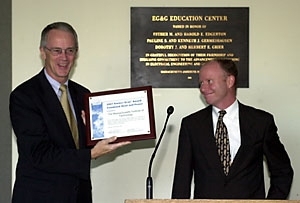Officials from the U.S. Environmental Protection Agency and the Department of Energy paid tribute Friday to MIT for increasing energy efficiency and reducing pollution at the William R. Dickson Cogeneration Facility.
The natural-gas-powered 20-megawatt facility has provided electricity, steam heat and chilled water to more than 100 MIT buildings since 1995.
"It's an example of how we need to lead this nation in conserving energy," Christian Fellner of the EPA told about 50 people at a ceremony in the atrium of Building 34, across Vassar Street from the facility. "Energy efficiency in this case means reducing pollution" and helping the growing number of children who suffer from asthma, he said.
The Vassar Street plant uses 28 percent less fuel and reduces emissions of nitrous oxides and carbon dioxide by more than 70 percent compared to regular plants producing electricity and heat separately, Fellner said. The environmental benefit is equal to removing 12,000 automobiles commuting through Cambridge each morning and night, he said.
"It means a lot to the people in this room to have the government recognize this achievement," President Charles Vest told the federal officials who presented him with the Energy Star Combined Heat and Power Award.
The Swedish engineering firm Asea Brown Boveri developed the plant's revolutionary combustion chamber to premix the fuel to assure complete combustion. Janos Beer, professor emeritus of chemical engineering, worked with the MIT Department of Facilities to adapt the company's invention for use in generating electricity, steam and chilled water for MIT.
PROJECT BEGAN IN 1995
Chief Facilities Officer Victoria Sirianni praised William Dickson, retired executive vice president, and Thomas E. Shepherd Jr., retired associate director of Physical Plant, for initiating the 10-year project in 1985. She noted that the expansion of the MIT power plant and the chilled water plant expansion had also won two awards from the American Institute of Architects and an award from the Boston Society of Architects for architect Harry Ellenzweig.
Dickson told the audience, which included Cambridge Vice Mayor Henrietta Davis, that the new gas-powered plant provides power to 5 million more square feet of buildings without using any more energy.
Peter Cooper, MIT's director of utilities, commented that the system has had "one outage in the past five years compared to three or four every summer" at the 26 MIT buildings that aren't connected.
Vest noted MIT was also working with the EPA to clean up the Charles River and make it swimmable.
"I can't wait to jump in!" he said. "I can't wait to water the lawns of MIT from the Charles!"
A version of this article appeared in MIT Tech Talk on October 30, 2002.






